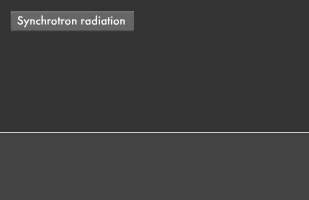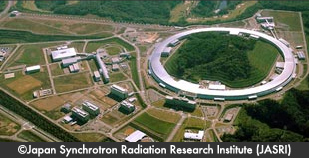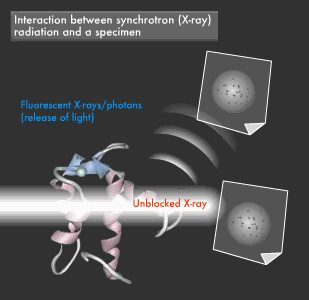Canon Science Lab
Synchrotron Radiation
Often referred, together with laser beams, as a "dream light source." Synchrotron radiation is artificial light created by accelerating electrons in the same direction.
Synchrotron radiation was observed at almost the same time that laser beams were first developed, about 50 years ago. Both laser beams and synchrotron radiation are artificial light sources, lasers being used as a source of light from infrared to ultraviolet ranges of the light spectrum, and synchrotron radiation as a source for the vacuum ultraviolet and X-ray range. Synchrotron radiation, which is created by accelerating electrons and changing their direction with a strong magnetic field, is high-energy light that covers a wide range of wavelengths. However, it can be created only in a synchrotron, a very large-scale facility, which is where the name of this light originated. As such, it is used mostly in research conducted at experimental facilities.
Manipulating High-Speed Electrons to Create Photons
Electrically charged particles such as electrons wear what could be described as a "cloak of light". This is what is behind electromagnetic force: the attraction between positive and negative charges, and repulsion between like charges. It is thought that electromagnetic force is generated when photons are thrown backwards and forwards. (For details, see "Light and Unit") The cloak of light surrounding particles is thought to consist of photons.

If an electron wearing such a cloak of light and traveling at a high speed is suddenly stopped in its path, the lightweight cloak is thrown forwards, and can be observed as an electromagnetic wave such as light or X-rays, depending on its speed and energy at the time it is thrown forward.
If the direction that a high-speed electron is traveling in is suddenly bent, the lightweight cloak will be unable to follow the distortion, but will instead continue traveling in a straight line. This, too, results in the creation of an electromagnetic wave. Such waves are called synchrotron radiation.
SPring-8: an Experimental Facility for the Use of Synchrotron Radiation
Imagine a huge, ring-shaped facility that accelerates electrons as they orbit the ring. This is a synchrotron, and it produces synchrotron radiation by bending the path of electrons and causing their cloaks of light to be thrown off as electromagnetic waves such as light or X-rays. The wavelength of this synchrotron radiation can be controlled by adjusting the speed (energy) of the orbiting electrons.

The synchrotron radiation emits outside through window holes located in the ring.
Actual ring-shaped synchrotrons experimental facilities accelerate electrons to about the speed of light in order to obtain synchrotron radiation of the X-ray region in the spectrum. This requires an extremely high voltage, and accordingly other very bulky devices in addition to the ring in order to control the electrons and ensure safety. The equipment required makes these facilities very large, which is why there are only about 20 worldwide. Japan's SPring-8 (an acronym for Super Photon ring-8 GeV) facility in Hyogo Prefecture is one of the world's most powerful synchrotrons. Its ring has a circumference of 1.4 kilometers.
Synchrotron Radiation Reveals the Inner Secrets of Materials
What kind of research is conducted at synchrotron experimental facilities such as SPring-8?
Synchrotron radiation is applied to examine and analyze atoms' structures and arrangements, to create new materials, and to pattern features smaller than the wavelength of ordinary light on semiconductors. It has proven to be particularly effective in analyzing the structure of proteins, research that is intimately connected with the development of new medicines. It is also being applied to geological and historical research, including the study of meteorites, cosmic dust, archaeological finds and fossils.

